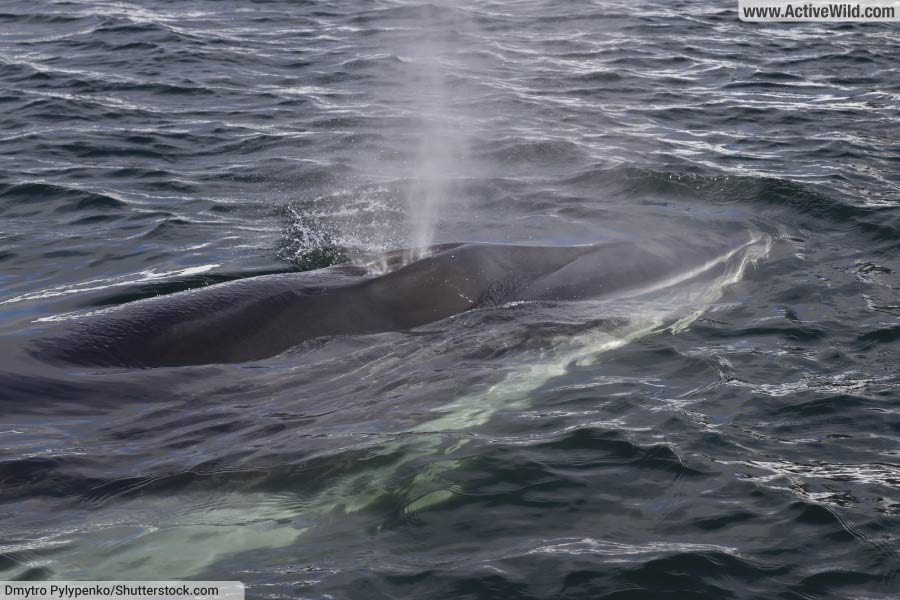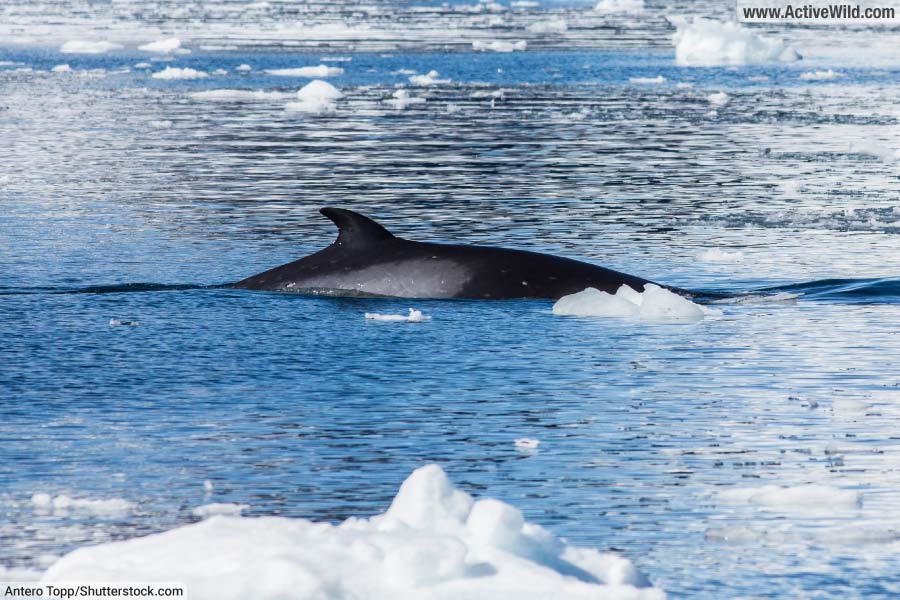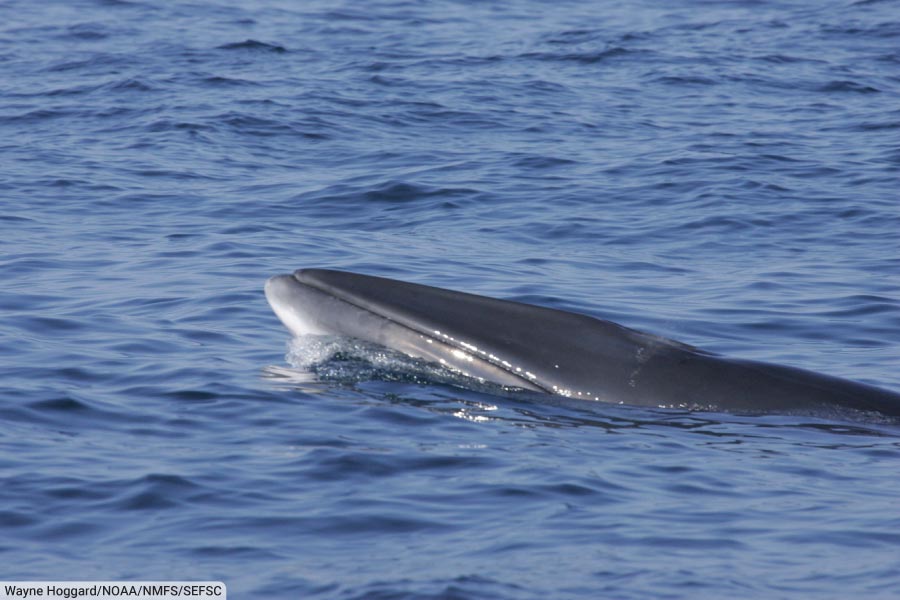The common minke whale is one of two species of minke whale. Unlike the closely-related Antarctic minke whale, which is typically found in the colder regions of the Southern Hemisphere, the common minke whale is found in oceans worldwide.
Read on to find out more about the common minke whale…
Page Index
- Common Minke Whale Facts
- What Is A Common Minke Whale?
- Common Minke Whale Statistics
- What Does A Common Minke Whale Look Like?
- Related Species
- Common Minke Whale Vs Antarctic Minke Whale
- Classification of the Common Minke Whale within Cetacea
- Range & Migration
- Diet & Hunting
- Common Minke Whale Life Cycle
- Is The Common Minke Whale Endangered?
- Population
- Predators
- Discover More with Active Wild
You can see a list of every whale species on this page: Types of Whales - Pictures & Facts on All Whale Species
Common Minke Whale Fun Facts & Stats

- The common minke whale is a baleen whale. Like all baleen whales, it lacks teeth, capturing its prey by filtering it from the water with comb-like baleen plates located in the mouth.
- The closest relative of the common minke whale is the Antarctic minke whale. The two minke whales belong to the rorqual whale family, Balaenopteridae.
- Rorqual whales are characterized by heavily ridged skin under their mouths. The folded skin allows the mouth to expand greatly for feeding.
- The common minke whale is the second-smallest baleen whale (the smallest is the pygmy right whale), and the smallest rorqual whale.
- The common minke whale’s blowholes (like those of all whales) are its nostrils, which over millions of years of evolution migrated from the front to the top of the head.
Common Minke Whale Statistics
- Scientific Name: Balaenoptera acutorostrata
- Order: Cetacea
- Family: Balaenopteridae
- Length: Up to 10 meters (33 feet)
- Weight: Up to 9,000 kg (19,841 lb)
- Where found: Minke whales are cosmopolitan, with potential sightings around the globe, including the North Atlantic, North Pacific, and Antarctic Oceans.
- IUCN conservation status: Least Concern
What Is A Common Minke Whale?
The common minke whale is a species of minke whale within the family Balaenopteridae. It is the smallest of the rorqual whales, with adults reaching lengths of up to 10 meters (33 feet) and weights of up to 9,000 kg (19,841 lb).
The species is characterized by a narrow, pointed rostrum, sleek body, and a small, falcate (sickle-shaped) dorsal fin located about two-thirds down the back.
The common minke whale can be found throughout the world's oceans, although it is most commonly found in the cooler waters of the North Atlantic, North Pacific, and Antarctic Oceans. It is a solitary species, generally seen alone or in small groups.
A carnivore, the whale’s diet consists mainly of small fish, krill and cephalopods.
Although the minke whale has been hunted for centuries, due to its relatively small size, it has not been targeted as much as other, larger species. As of July 2023, the species is rated “Least Concern” by the IUCN.
What Does A Common Minke Whale Look Like?

The common minke whale is one of the smallest rorqual species, second only to the pygmy right whale. Adult common minke whales typically reach a length of up to 10 meters (33 feet), with females generally being slightly larger than males. Individuals can weigh as much as 9,000 kg (19,841 lb).
The common minke whale has a sleek and streamlined body, ideal for efficient swimming. It has a narrow, pointed rostrum, and its body is typically dark grey or black on top and white underneath, a common camouflage pattern known as countershading.
One of the most distinctive features of the common minke whale is a white band on each flipper, which can be seen clearly when it breaks the surface of the water.
The common minke whale has a small, falcate (curved) dorsal fin that is located about two-thirds down the back. This dorsal fin is more pointed than in many other rorquals and becomes visible when the whale surfaces to breathe.
Like all baleen whales, the common minke whale has two blowholes. (Toothed whales have only one blowhole.)

Related Species
The common minke whale belongs to the rorqual whale family, Balaenopteridae. Its closest relative is the Antarctic minke whale, sometimes known as the southern minke whale.
Common Minke Whale Vs Antarctic Minke Whale

Both the common minke whale (Balaenoptera acutorostrata) and the Antarctic minke whale (Balaenoptera bonaerensis) are members of the rorqual family (Balaenopteridae), characterized by their streamlined bodies, pleated throat grooves, and a dorsal fin.
Size is one of the major differences between the two species. While the common minke whale reaches up to 10 meters (33 feet) in length, the Antarctic minke whale is slightly larger, typically reaching lengths of up to 10.7 meters (35 feet) in females. The weight also varies accordingly.
Another difference is their distribution. As its name suggests, the common minke whale has a wider distribution, and is found throughout the world's oceans. In contrast, the Antarctic minke whale is largely confined to the colder waters of the Southern Hemisphere, specifically the Antarctic and sub-Antarctic waters.
Both species have a dark back and light undersides. However, while the common minke whale has a distinctive white band on each flipper, the Antarctic minke whale's flipper band is often less distinct or absent.

Classification of the Common Minke Whale within Cetacea
The common minke whale belongs to a group (the infraorder Cetacea) of marine mammals known as cetaceans. The group consists of all species of whales, dolphins, and porpoises.
Cetaceans are divided into two main groups: toothed whales (parvorder Odontoceti) and baleen whales (parvorder Mysticeti). The common minke whale is a baleen whale. Like all baleen whales, it lacks teeth and is a filter feeder, using comb-like baleen plates located in the mouth to separate food from the water.
The common minke whale belongs to the rorqual whale family, Balaenopteridae, a group of baleen whales characterized by their streamlined bodies, pleated throat grooves, and the presence of a dorsal fin.
Range & Migration
The common minke whale is a cosmopolitan species, found in a variety of oceanic environments around the globe. The species is typically found in cooler waters, rather than tropical waters.
In the North Atlantic, the common minke whale may be spotted off the North American coasts, ranging from Maine up to the Arctic Ocean, and from Greenland and Iceland extending to the coasts of Norway in Europe.
In the North Pacific, the species’ extends from the Bering Sea and the Sea of Okhotsk, down to the East China Sea, and as far east as the Californian coast.
The common minke whale is also present in the Southern Hemisphere, but is typically replaced by the closely-related Antarctic minke whale (Balaenoptera bonaerensis) in Antarctic waters.
The common minke whale is known to make long-distance migrations, with one individual having been tracked traveling 2,300 mi / 3,700 km over 100 days.
Diet & Hunting
The common minke whale primarily feeds on small schooling fish and invertebrates. The species’ diet varies based on the region and availability of food, but commonly includes species such as herring, capelin, and sand eels. In addition, it consumes large amounts of krill and other small crustaceans.
The common minke whale uses the baleen plates in its mouth to filter feed. The whale takes a large gulp of seawater, then pushes the water out through the baleen plates, trapping the food items inside its mouth. It then swallows its prey whole.
Despite its size, the whale’s throat is relatively small, so the food it eats is generally small in size. This feeding method allows the whale to consume a significant amount of food each day.
Common Minke Whale Life Cycle
The common minke whale typically gives birth in the warmer waters of lower latitudes during the winter months. At birth, the calves are approximately 2.4-2.8 meters (7.9-9.2 feet) long and they are nursed by their mothers, feeding on a diet of rich, fatty milk.
After a nursing period that can last for several months, the calf begins to eat solid food and starts to grow rapidly. Minke whales are believed to reach sexual maturity at around 3-8 years of age, with females typically maturing slightly earlier than males.
The gestation period of a common minke whale lasts approximately 10 months, after which the female gives birth to a single calf. Breeding typically occurs once every two years for a female minke whale, although this can vary.
Common minke whales are believed to live for up to 50 years, though estimates vary.
Is The Common Minke Whale Endangered?
The common minke whale is not an endangered species. The species is currently (as of July 2023) listed as "Least Concern" on the IUCN Red List of Threatened Species.
Like all marine mammals, the common minke whale faces threats from numerous human activities, including entanglement in fishing gear, ship strikes, and noise pollution.
Population
The common minke whale’s global population is currently estimated to consist of 200,000 mature individuals.
Predators
The common minke whale’s size and speed protect it from most ocean predators. The species’ main predator is the killer whale, with younger, smaller individuals being most at risk from attack.
Large shark species may also occasionally prey on the whale.
Discover More with Active Wild
You can see a list of every whale species on this page: Types of Whales - Pictures & Facts on EVERY Whale Species
Visit our main animals page for links to animal information and a complete guide to the animal kingdom: Animals
You can see pictures and facts on EVERY species of dolphin on this page: Types of Dolphins
You can see more ocean animals on this page: Ocean Animals List with Pictures & Facts

